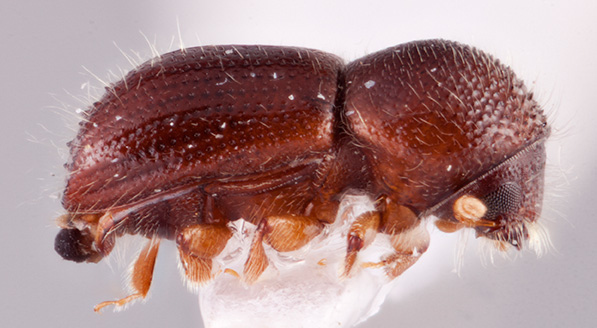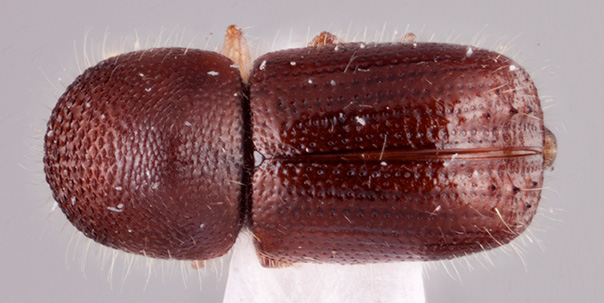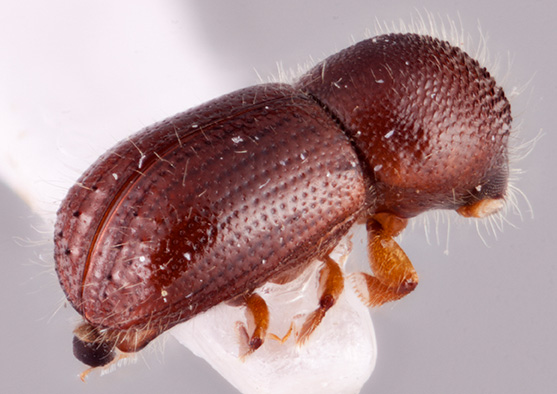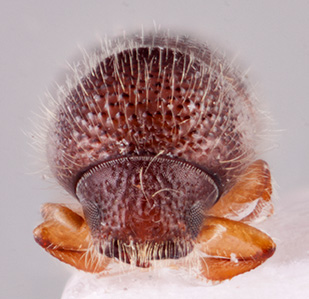Ambrosiodmus asperatus
|
Ambrosiodmus asperatus lateral; R.K. Osborn |
|
Ambrosiodmus asperatus dorsal; R.K. Osborn |
|
Ambrosiodmus asperatus declivity; R.K. Osborn |
|
Ambrosiodmus asperatus frontal; R.K. Osborn
|
Taxonomic history
Xyleborus asperatus Blandford, 1895: 321.
Ambrosiodmus asperatus (Blandford): Wood, 1989: 169.
Synonyms
Xyleborus nepotulus Eggers, 1923: 179. Schedl, 1958c: 151.
Xyleborus citri Beeson, 1930: 215. Wood, 1989: 169.
Xyleborus nepotulomorphus Eggers, 1936b: 88. Schedl, 1958c: 151.
Diagnosis
2.5−2.8 mm long (mean = 2.64 mm; n = 5); 2.4−2.8 times as long as wide. This species can be distinguished by declivitaldeclivital:
pertaining to the elytral declivity
interstriae 2 bearing a row of 3−5 denticlesdenticle:
a small tooth, the sides of which are equal and the tip is above the middle of the base that are larger than those on other interstriae; and declivitaldeclivital:
that are larger than those on other interstriae; and declivitaldeclivital:
pertaining to the elytral declivity
interstriae 1 distinctly impressedimpressed:
a depression in a surface
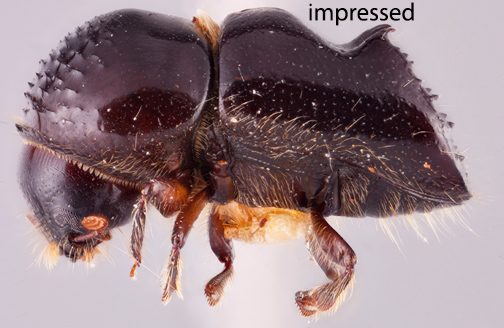 .
.
This species has a very similar appearance and size to several Ambrosiophilus species which also have 3−4 denticlesdenticle:
a small tooth, the sides of which are equal and the tip is above the middle of the base on declivitaldeclivital:
on declivitaldeclivital:
pertaining to the elytral declivity
interstriae 2. The two genera are easily separated by the pronotalpronotal:
pertaining to the pronotum
sculpturing: discdisc:
the flat central upper surface of any body part (e.g. pronotum and elytra) punctate in Ambrosiophilus and asperateasperate:
punctate in Ambrosiophilus and asperateasperate:
covered in asperities in Ambrosiodmus.
in Ambrosiodmus.
May be confused with
Ambrosiophilus cristatulus, A. osumiensis, and A. subnepotulus
Distribution
Australia, Brunei, China (Guizhou, Guangxi, Hainan, Hong Kong, Xizang), India (Tamil Nadu, West Bengal), Indonesia (Java, Sulawesi, Sumatra), Japan (Ryukyu Is), West Malaysia, Nepal, New Guinea, Sri Lanka, Taiwan, Thailand, Vietnam
Host plants
polyphagous (Beaver and Liu 2010Beaver and Liu 2010:
Beaver RA, Liu L-Y. 2010. An annotated synopsis of Taiwanese bark and ambrosia beetles, with new synonymy, new combinations and new records (Coleoptera: Curculionidae: Scolytinae). Zootaxa 2602: 1-47. https://doi.org/10.11646/zootaxa.2602.1.1)
DNA data
Sequences available for COI and CAD.
COI: HM064047.1; MN619818; MN619819; MN619820; MN619821; MN619822
CAD: HM064226.1; MN620113; MN620114; MN620115; MN620116; MN620117

